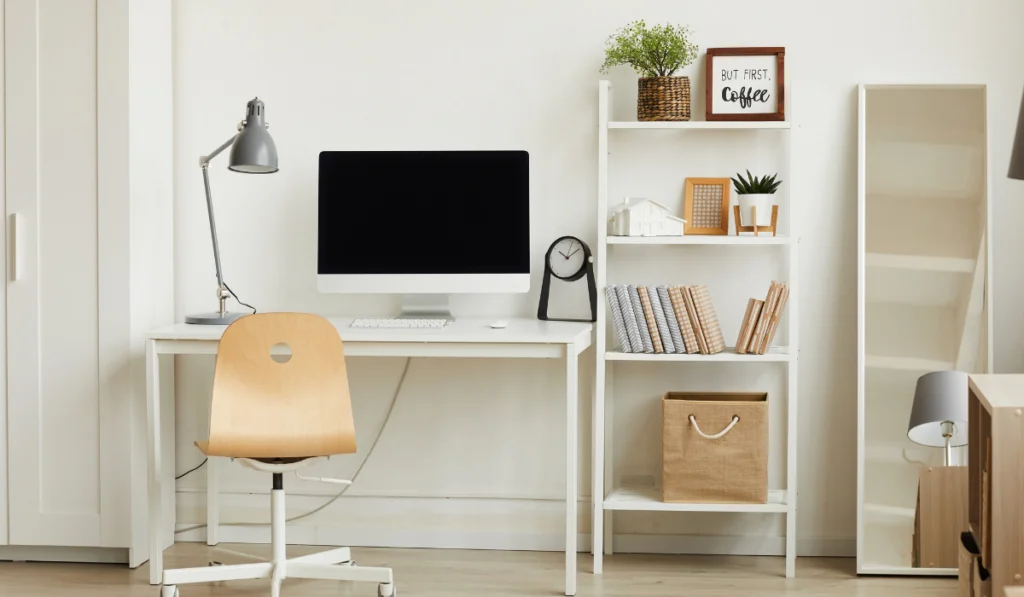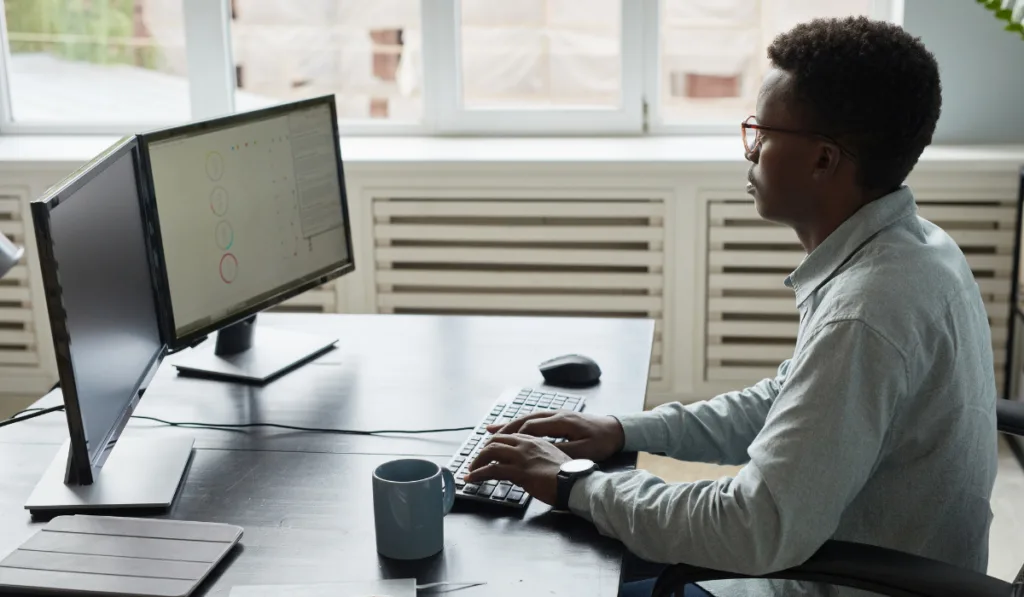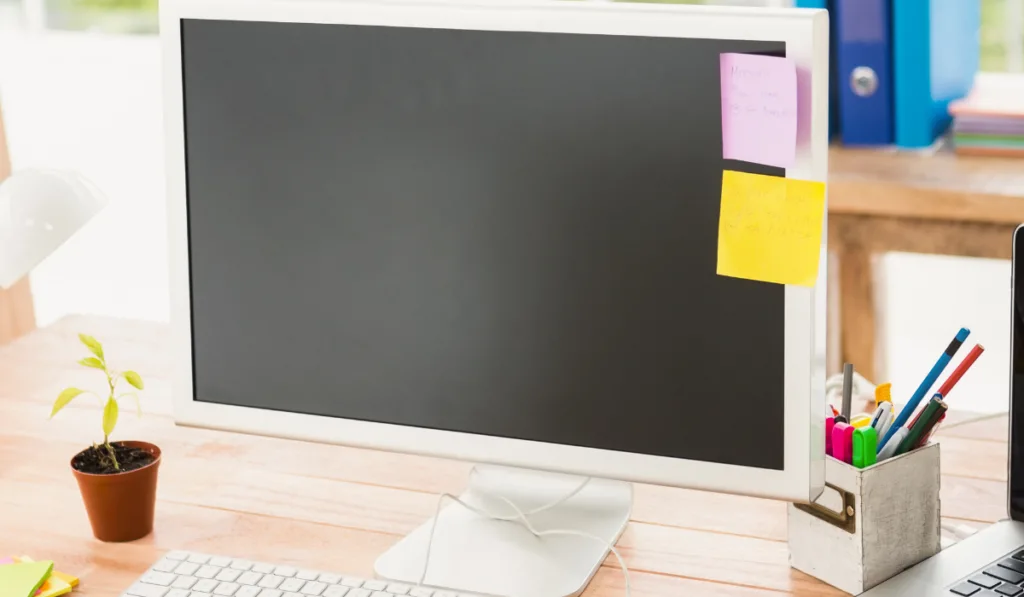Working from home enables you to design your home office in a manner that suits your style, taste, and comfort. Your desk is arguably the most vital piece of furniture in your workspace, making desk placement a pivotal part of the layout for your home office.
With all the distractions that could come from working at home, it’s important that your desk is set up in the best way to maximize productivity.
The best direction to position your work desk at home is at the back of the room, at a diagonal angle, facing the door so that you can see the entire space. In this position, you will be able to see anyone entering your workspace and also not feel boxed into the room.

However, the best direction for your work desk may depend on your personal preferences. There are various factors that you should take into consideration when deciding where to place your desk.
Table of Contents
Factors to consider when deciding where to put your desk
Here are some factors you should consider when determining the best direction to place your work desk at home.
1. The View from your desk
If you are someone who finds having a nice view helps you feel more motivated or less constricted, perhaps consider angling your desk towards the view to keep morale high while you work.
Having your desk situated in view of or in sunlight can help boost your mood, provide a good source of vitamin D and provide natural light while you work.
If you are someone who gets easily distracted, then positioning your desk away from distractions is important.
If you have family members who may pass by the window or door, or think that a beautiful view might capture your eye for too long, perhaps consider having your desk face a wall to avoid distractions. You can always admire the view during your break.
Facing a wall does not necessarily mean you have to stare at a blank wall. Perhaps put up a beautiful piece of artwork or quotes that inspire you to continue being productive.

2. Size of your desk
Assessing the size of your desk will help determine the best place to fit your desk.
If you are someone who feels overwhelmed in small spaces, consider placing your desk close to a wall so that it takes up as little space as possible.
This does not necessarily mean you have to face the wall. It’s entirely possible for you to have your back facing the wall and your desk looking out onto the rest of the room.
If you have a large desk, it may fit nicely in the center of the room. This will, however, also depends on the size of your room.
3. The layout of your room
If you share your workspace with someone else, consider balancing out the room by putting a desk on either side of the room. This way, you will not be in the other person’s space, and the layout of your office will have a nice balance.
The location of your electrical outlets is an important consideration for desk placement.
Ideally, you would like to place your desk near an electrical outlet to charge your devices. Some homes have electrical outlets in the wall, which would indicate placing your desk near the wall.
Conversely, in some homes, the electrical outlets are situated in the center of the room, making it more convenient to place your desk in the center of the room.
However, the location of your electrical outlets should not be a deciding factor as it is possible to get an extension cord if your desk is situated far from the electrical outlet.
If you are someone who prefers a clutter-free desk, consider locating your desk within arm’s reach of anything you might need, such as stationery or books.

4. Design of your room
Built-ins, lighting, furniture, windows, and doors will determine how much space you have to work with for your desk placement.
Putting your desk in the center of the room directly underneath the room’s main light fixture will provide you with more light while working and make the room look more centered.
Using Feng Shui to determine the best direction for your work desk at home
Feng Shui is a Chinese traditional practice conceptualized on using energy forces to harmonize individuals in their environment.
According to Feng Shui, it is best to place your work desk at the back of the room in a diagonal facing the door.
This position is often referred to as the ‘power position.’ In this position, you can see anyone entering the room, but you are not sitting directly opposite the door, so energy will slow down and come to you.
If you cannot position your desk to be diagonal to the door, alternatively position your desk to be located in the southwest corner of the room as this is regarded as a corner of power.
According to Feng Shui principles, you should have an aesthetically pleasing and inspiring view, rather than a blank wall that may cause you to feel like you are bumping into obstacles.
You should avoid sitting with your back facing a window and have a solid wall behind you, as having a window behind you means that energy can stab you in the back.

Similarly, you should not have the door behind you because you may miss out on opportunities if you cannot see the door.
Furthermore, you should not have a beam directly above your workspace, as this symbolizes oppression and being under pressure.
Finally, Feng Shui principles dictate that your desk should face your lucky direction based on your Kua number.
- Kua number 5 is the same as Kua number 2 for males and Kua number 8 for females.
- If your Kua number is 1, 3, 4, or 9, then North, East, South, and South-East would be the ideal direction to place your desk.
- If your Kua number is 2, 6, 7, or 8, then West, North-East, South-West, and North-West would be the ideal direction to place your desk.
Using Vastu Shastra to determine the best direction for your work desk at home
Vastu Shastra is the traditional Indian science of architecture that provides guidelines to setting out your environment in a way that heightens positive energy.
According to Vastu Shastra, your work desk should be facing the Southwest direction, while your seated position while working should ideally be facing North-East to remain productive and inspired.
North is of significance because it is the direction of Kuber, the god of money, and East is the direction of sunrise, indicating growth in all senses.
Vastu Shastra recommends that office desks be regular shapes such as rectangles or squares as irregular shapes create confusion, promoting delays.

It is also advised that you keep the desk clear of clutter because clutter can create disorientation. In this regard, it is important that you set up your desk in a clean, clutter-free environment.
If it is not possible to find an entirely clutter-free, clean area, try to ensure that your desk is directed away from the clutter so that you will have your back to it and not be distracted while you work.
What is the best location for a home office?
Ideally, your home office should be set up in a distinguishable space for work only so that you can leave this space and feel at rest within your home at the end of the day.
The best location for a home office is ideally a spare room that could be turned into an office. However, any space that is free from distractions and is quiet and clutter-free should suffice.
Conclusion
The principles of Vastu Shastra and Feng Shui provide important considerations to take into account when determining which direction is best for your work desk at home.
The best direction to place your desk entirely depends on your personal preference and the space in which you are working. At the end of the day, the direction you find yourself most productive in is the best direction.
Resources
- https://www.thespruce.com/what-is-feng-shui-1275060
- https://plankandpillow.com/best-desk-placement-for-your-home-office/
- https://www.engelvoelkers.com/en/blog/interior-design/office/best-ways-to-position-and-organise-your-desk-in-your-home-office/
- https://www.fengshui-tips.org/feng-shui-home-office.html
- https://www.livspace.com/in/magazine/vastu-vs-feng-shui
- https://timesofindia.indiatimes.com/astrology/vastu-feng-shui/vastu-and-work-place/articleshow/68206938.cms
- https://rawriters4hire.medium.com/where-should-you-locate-your-home-office-ac7eb7a90bc
